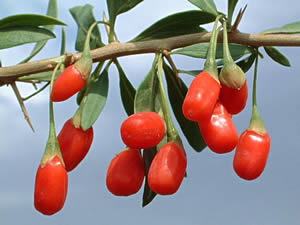Goji or goji berry is the common name for the fruit of related species Lycium barbarum and L. chinense. The goji is a deciduous and fruitful shrub that belongs to the nightshade family (the same as tomatoes and potatoes) and is very popular in China for being a tasty and functional food, even considered a remedy. Currently, goji is gaining followers worldwide with the spread of Eastern culture in the West.
The goji presents a branched stem, with sparse, thorny foliage, and initially herbaceous texture, which gradually becomes woody over time. It varies in height from 1 to 4 meters (about 3 to 13 feet), but usually does not exceed 2 meters (about 6.5 feet). The leaves are lanceolate to oval, green, membranous, and can be solitary and alternate or fasciculated and in groups of up to three leaves.
The flowers are hermaphroditic, axillary, and grow in the summer, in groups of 1 to 3, featuring a bell-shaped calyx and corolla in the shape of a funnel, purple in color. The fruits appear in the fall and are small oblong or ovoid, red berries with about 6 to 16 brown seeds.
In landscaping, goji serves as a solitary shrub or in groups, being interesting for the formation of living fences. It can be planted in pots and, if provided support and tying, can be led as a climbing plant. Pruning, carried out after fruiting, renews the foliage and stimulates the formation of a more compact and full shrub. It is an interesting species to attract birds, who eagerly devour the tasty fruits.
In cooking, it can be consumed in various ways, the most common being as dried fruit, similar to raisins, and can be mixed into yogurt or breakfast cereals. Its flavor resembles tomato, cherry, and raisin, with a nutty touch. However, it can also be consumed fresh, in juices, jellies, liqueurs, wines, and even in savory dishes, with chicken, pork, vegetables, soups, salads, sauces, and rice.
The leaves are used as salad and in the preparation of infusions. Goji is a very nutritious fruit loaded with vitamins, fibers, minerals, and natural antioxidants, such as Vitamin C and flavonoids. In China, daily consumption of the fruit is associated with a long and healthy life.
Harvesting goji should be careful. The fruits are sensitive and bruise easily. Dehydration can be performed in the sun. Caution: There are reports of changes in blood coagulation levels in elderly people who consumed the tea. Do not use as a herbal remedy without your doctor’s knowledge. There is also suspicion that the green fruit may be toxic. Always consume when fully ripe.
It should be cultivated under full sun, in fertile, slightly alkaline, well-drainable soil, enriched with organic matter, and irrigated regularly. It appreciates hot and dry climates but is capable of adapting to humid environments. Despite tolerating cold, its cultivation in greenhouses is interesting during the harsh winter of temperate places.
Fruiting begins about 1 to 3 years after planting. It multiplies by cutting of woody branches and by seeds that germinate easily.


